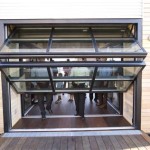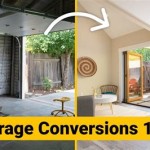How to Turn a Carport Into a Garage
Converting a carport into a fully enclosed garage can significantly enhance a property's value, security, and functionality. A carport provides basic shelter from the elements, but a garage offers enhanced protection for vehicles, storage space, and a potential workshop area. This conversion process requires careful planning, adherence to local building codes, and a methodical approach to construction. The following outlines the essential steps and considerations involved in transforming a carport into a functional and aesthetically pleasing garage.
Planning and Preparation: The Foundation of a Successful Conversion
Prior to commencing any physical modifications, thorough planning is crucial. This stage involves assessing the existing carport structure, understanding local regulations, and developing a comprehensive design plan.
Assessing the Existing Structure: The initial step is to evaluate the integrity of the existing carport. This includes examining the foundation, support posts, and roof structure. The foundation must be strong enough to support the weight of new walls and a garage door. Look for any signs of cracking, settling, or water damage. Support posts must be structurally sound and properly anchored to the foundation. The roof should be in good condition and capable of withstanding the added stress of enclosing the space. If any structural weaknesses are identified, reinforcement or repairs are necessary before proceeding.
Understanding Local Building Codes and Permits: Building codes vary significantly between jurisdictions. Contacting the local building department is imperative to determine the specific requirements for converting a carport into a garage. This includes zoning regulations, setback requirements, height restrictions, and required inspections. Obtain the necessary permits before starting any construction work. Failure to comply with building codes can result in fines, delays, and even the requirement to dismantle non-compliant structures. The permitting process typically involves submitting detailed plans and specifications for review and approval.
Developing a Detailed Design Plan: A well-defined design plan is essential for a successful conversion. This plan should outline the dimensions of the garage, the location of the garage door, the type of materials to be used, and any electrical or plumbing work that will be required. Consider the intended use of the garage. Will it be primarily for vehicle storage, or will it also serve as a workshop or storage area? This will influence the layout and the need for additional features such as workbenches, shelving, and electrical outlets. The design plan should also address ventilation and insulation requirements. Proper ventilation prevents the buildup of moisture and fumes, while insulation helps to regulate temperature and reduce energy costs.
Budgeting and Material Selection: Establish a realistic budget that accounts for all costs, including materials, labor (if hiring contractors), permits, and potential unforeseen expenses. Research and compare the prices of different materials. Common materials for garage walls include wood framing, concrete blocks, and metal studs. The choice of material will depend on factors such as cost, durability, and aesthetic preferences. Select a garage door that complements the style of the house and provides adequate security. Consider the type of insulation to be used and the cost-effectiveness of different options. Obtain quotes from multiple contractors to ensure competitive pricing if professional assistance is needed.
Construction Process: Enclosing the Carport
The construction phase involves physically transforming the carport into an enclosed garage. This typically includes framing the walls, installing a garage door, adding a pedestrian door (optional), and finishing the interior and exterior.
Framing the Walls: The first step is to frame the walls using the chosen material. If using wood framing, construct the wall frames using pressure-treated lumber for the bottom plate, which will be in contact with the concrete foundation. Ensure that the frames are square and plumb. Secure the bottom plates to the foundation using concrete anchors or powder-actuated fasteners. Erect the wall frames and brace them temporarily to ensure stability. Connect the wall frames to the existing carport structure, ensuring a secure and weather-tight connection. If using concrete blocks, lay the blocks in courses, ensuring that each course is level and plumb. Reinforce the walls with rebar as needed. If using metal studs, assemble the frames in a similar manner to wood framing, using screws to connect the metal components. Metal studs are lightweight and resistant to rot and insects.
Installing the Garage Door: Installing the garage door requires careful attention to detail to ensure proper operation and safety. Follow the manufacturer's instructions closely. Install the tracks and hardware according to the specifications. Ensure that the door is properly balanced and that the safety features, such as the auto-reverse mechanism, are functioning correctly. Consider hiring a professional garage door installer for this task, as it can be complex and potentially dangerous.
Adding a Pedestrian Door (Optional): A pedestrian door can provide convenient access to the garage without having to open the entire garage door. This is particularly useful if the garage is used as a workshop or storage area. Frame the opening for the pedestrian door and install the door according to the manufacturer's instructions. Ensure that the door is weather-stripped to prevent drafts and water intrusion.
Exterior Finishing: The exterior of the garage should blend seamlessly with the existing house. Choose siding that matches or complements the existing siding. Install the siding according to the manufacturer's instructions. Pay attention to detail to ensure a clean and professional finish. Trim the edges of the siding and install corner boards to provide a finished look. Paint or stain the siding to match the existing house, or choose a complementary color. Seal any gaps or cracks with caulk to prevent water intrusion.
Interior Finishing: The interior of the garage can be finished to suit the intended use. Insulate the walls and ceiling to improve energy efficiency and reduce noise. Install drywall or plywood on the walls and ceiling to create a smooth surface. Tape and mud the seams and sand them smooth. Paint the walls and ceiling with a durable paint that is resistant to moisture and stains. Install electrical outlets and lighting fixtures as needed. Consider adding a concrete sealant to the floor to protect it from oil stains and other spills.
Electrical and Other Considerations
Converting a carport into a garage often requires electrical work and may involve other considerations such as ventilation and drainage.
Electrical Wiring: Electrical work should be performed by a licensed electrician to ensure safety and compliance with building codes. Wiring must be properly grounded and protected. Install sufficient electrical outlets to meet the needs of the garage. Consider adding dedicated circuits for power tools or appliances. Install lighting fixtures to provide adequate illumination. A garage door opener requires a dedicated electrical circuit. Ensure that all electrical work is inspected by the local building department.
Ventilation: Proper ventilation is essential to prevent the buildup of moisture, fumes, and gases in the garage. Install vents in the walls or roof to allow for air circulation. Consider installing an exhaust fan to remove fumes from the garage. Ensure that the garage door is properly sealed to prevent drafts and water intrusion.
Drainage: Ensure that the area around the garage is properly graded to prevent water from pooling around the foundation. Install gutters and downspouts to direct rainwater away from the garage. If necessary, install a French drain to divert groundwater away from the foundation.
Security: Enhance the security of the garage by installing a secure garage door and a sturdy pedestrian door (if applicable). Consider adding a security system with motion detectors and alarms. Install outdoor lighting to deter intruders.
Converting a carport into a garage is a significant undertaking that requires careful planning, attention to detail, and adherence to local building codes. By following these steps, it is possible to transform a simple carport into a functional and valuable addition to a property.

How To Convert A Carport Into Garage Examples

Transforming A Carport Into Garage Garaga

You Asked We Answered Turn Your Carport Into A Garage

Checklist For A Carport To Garage Conversion

Turn Carport Into Garage Modern Solutions Statek Wood

How Much Does It Cost To Convert A Carport Into Garage 2024 Data Angi

Vancouver Carport Conversion To Garage

Convert A Carport Into Garage How To Guide

3 Ways To Convert Your Carport Into A Metal Garage General Steel

Dixie Door Carport Enclosure Gates Custom Projects
Related Posts








